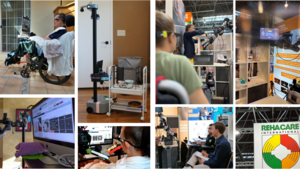Publikationen
Ausgewählte Publikationen
Hier finden Sie ausgewählte Publikationen aus den letzten Jahren. Eine ausführliche Liste der Publikationen finden Sie auf der Google Scholar oder DBLP Seite von Stefan Schneegaß.

Art der Publikation: Beitrag in Sammelwerk
Multiple Ways of Working with Users to Develop Physically Assistive Robots
- Autor(en):
- Nanavati, Amal; Pascher, Max; Ranganeni, Vinitha; Gordon, Ethan K.; Faulkner, Taylor Kessler; Srinivasa, Siddhartha S.; Cakmak, Maya; Alves-Oliveira, Patrícia; Gerken, Jens
- Titel des Sammelbands:
- A3DE '24: Workshop on Assistive Applications, Accessibility, and Disability Ethics at the ACM/IEEE International Conference on Human-Robot Interaction
- Veröffentlichung:
- 2024
- Digital Object Identifier (DOI):
- doi:10.48550/arXiv.2403.00489
- Volltext:
- <a href="/fileadmin/fileupload/I-HCI/A3DE_Submission_5_Nanavati-Pascher_Paper.pdf" class="pdf">Multiple Ways of Working with Users to Develop Physically Assistive Robots (2,59 MB)</a>
- Zitation:
- Download BibTeX
Kurzfassung
Despite the growth of physically assistive robotics (PAR) research over the last decade, nearly half of PAR user studies do not involve participants with the target disabilities. There are several reasons for this---recruitment challenges, small sample sizes, and transportation logistics---all influenced by systemic barriers that people with disabilities face. However, it is well-established that working with end-users results in technology that better addresses their needs and integrates with their lived circumstances. In this paper, we reflect on multiple approaches we have taken to working with people with motor impairments across the design, development, and evaluation of three PAR projects: (a) assistive feeding with a robot arm; (b) assistive teleoperation with a mobile manipulator; and (c) shared control with a robot arm. We discuss these approaches to working with users along three dimensions---individual- vs. community-level insight, logistic burden on end-users vs. researchers, and benefit to researchers vs. community---and share recommendations for how other PAR researchers can incorporate users into their work.
